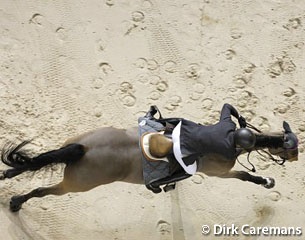
Hooked on the more natural form of horse foot health, well known US dressage competitor and trainer Shannon Peters made the move to barefoot or performance trimming for the health and long term soundess of her horses.
“My motivation to try barefoot trimming started because one of my FEI horses was chronically sore footed in normal shoes,” Shannon told Eurodressage. “However, we found that he would be perfectly sound each time we took him barefoot.”
What began with one problem horse evolved from there and today Shannon has almost all of her horses enjoying the benefits of barefoot and most of her student's horses as well. "It was my idea to try it in the beginning, my farrier at the time did not suggest it and it was definitely not the norm for performance horses," she admitted. "I switched over to a qualified barefoot trimmer Sossity Gargiulo and her husband Mario.”
Shannon advises that there is truly a difference in a “barefoot trim” and the "pasture trim" that most farriers use and that horse lovers must be sure to find a farrier who can perform the right one. “I believe barefoot trimming is good for all horses. Even horses with bad hooves -- mine being one of them -- can perform well if the foot is given enough time to heal.”
Wondering why the technique is so rare among competition horses, Shannon believes there is a misconception about one’s ability to train and compete horses barefoot. “I have several horses that may have needed to work in boots initially, when they first came out of the shoes," she explained. "On these horses I use Easboot Gloves, but they all eventually have been able to train and compete without the extra protection, even the GP horses.”
Peters hopes that this more natural shoeing method gets more popular for “our horses sake” and she believes the growth in barefoot shoeing will come from an increase in rider awareness and knowledge of the subject. “If people learn that there are ways to make their horses more sound, increase the longevity of their partners, and have happier and healthier partners, I can’t see why barefoot trimming won’t continue to grow in competitive dressage,” she stated.
Certain that it has improved all of her horses' hooves, Shannon believes that the method restores the symmetry of the hoof, among many other noticable improvements. “The natural blood pumping mechanism of the foot starts to work properly again, legs tighten up, and the horses are just, in general, more sound. Also their self-carriage improves, as well as straightness, willingness to move forward; the list goes on.”
With 12 of her horses working barefoot, Shannon has now been using this method for three years and does not see any change to her alternative shoeing approach in the near future. “I don't see that changing. I have so far had no reason to put shoes back on my horses. All of the horses have trained better, are more fit, balanced, and sound, than ever before."
As for negative side effects, Shannon is convinced there are “none whatsoever," and while the practice is also less expensive, that is not her motivation to go barefoot. “I would pay twice the amount for the health of my horses.”
Going Against the Grain, Barefoot Trimming
Dedicating several years researching hoof problems in horses, Dr Melanie Quick has spent almost 40 years working with horses and as an equine lameness veterinarian, animal chiropractor, acupuncturist, farrier and trimmer, Melanie knows all about the benefits of barefoot. “I have spent the last 8 years intensively researching the pros and cons of the various trimming methods,” says Dr Quick. “I was confident within 6 months of starting barefoot trimming that it could achieve profound results with the correct application. However, there was a lot of research I had to do to figure out why there seemed to be a variability in the results achieved on the larger horses. I have been happy that I’ve solved these issues in the last couple of years, and now I need to write a book on it!”
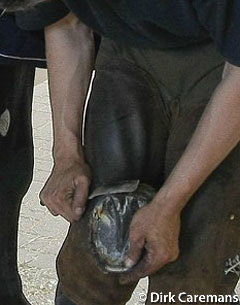 Quick first heard about barefoot trimming in 2002 and initially thought the concept was just another fad. “I was absolutely certain it was not possible for working horses to be barefoot, especially bigger horses," she admitted.
Quick first heard about barefoot trimming in 2002 and initially thought the concept was just another fad. “I was absolutely certain it was not possible for working horses to be barefoot, especially bigger horses," she admitted.
First attempting the method in 2004 Melanie recommends barefoot trimming to anyone prepared to do their research! “I advise owners who are willing to educate themselves on how best to maximize hoof health and will therefore be able to cope with the occasional inconvenience of having a barefoot horse," she said.
Led into barefoot trimming out of frustration with traditional shoeing techniques, Melanie was herself an excellent steel shoe farrier, but had the wisdom and experience to see things differently. "I was frustrated at having horses develop hoof problems and hoof related lamenesses, despite them being in the care of an excellent farrier (myself)," she explained. "However, once you learn about the correct physiology and function of the foot, and you learn why certain conditions such as joint disease, navicular syndrome, seedy toe, flares, cracks etc really occur, it’s hard to continue practicing methods that compromise hoof health."
With “unbelievably good” results Melanie continues to be amazed at what the change to barefoot trimming can do with approximately 40% of her clientele now opting for this alternative method. “I have an unusually high amount of barefoot clients due to my reputation in this area of expertise.”
With a large part of the equine community still skeptical about the use of barefoot, Melanie has clients who are competing barefoot horses in
Prix St Georges, Intermediaire, and Grand Prix level dressage, but none of which wish to speak out. “They have all suffered large amounts of emotional distress due to enormous peer group pressure from instructors, other competitors, judges, vets and farriers against their choice to have a barefoot horse, and so would prefer to remain anonymous.”
Still a relatively uncommon practice, the most common barefoot adoptees are people who have horses suffering from navicular/laminitis and other non-resolving lamenesses. They have been told to retire or euthanize their horses. “But it can also be those who’ve heard rumors of the health benefits," Quick added
Certain that all horses can successfully live a barefoot lifestyle, Melanie first advises that the owner be taught the various nuances in the technique and management required for their individual horse. Horses who have pre-existing hoof pathology that is causing lameness in their shoes may struggle on some of the competition arena surfaces as the dressage rules do not allow hoof boots. Horses who compete on grass arenas usually do not require boots and have no problem being barefoot.
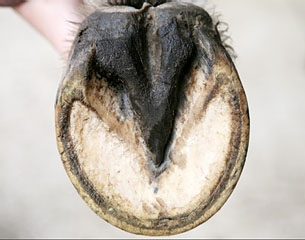 Horses with minimal hoof pathology can tolerate the poorer quality competition arenas, and will be very successful barefoot athletes. Horses who compete in sports which allow hoof boots will also be highly successful. Some horses get to a certain stage of hoof disease (navicular/laminitis/DDF lesions/collateral ligament injuries) where they absolutely cannot maintain soundness in shoes, and if they can compete on grass arenas they are fine, but these horses will usually require boots on non grass arenas.
Horses with minimal hoof pathology can tolerate the poorer quality competition arenas, and will be very successful barefoot athletes. Horses who compete in sports which allow hoof boots will also be highly successful. Some horses get to a certain stage of hoof disease (navicular/laminitis/DDF lesions/collateral ligament injuries) where they absolutely cannot maintain soundness in shoes, and if they can compete on grass arenas they are fine, but these horses will usually require boots on non grass arenas.
Hearing of a horse that was forever lame with shoes, but became even after going barefoot, Melanie says that unfortunately despite the convenience of shoes, they grossly compromise blood flow to the foot. “The peripheral (wall) loading in a foot when shod reduces blood flow and also markedly increases the shock and vibration of ground impact traveling up the leg, hence numerous tissues within the hoof capsule and pastern (and up to the knee and hock) deteriorate in health and strength. Changing to a barefoot lifestyle returns a more correct level of blood flow to the foot and hence the damaged tissues have a chance to heal. In addition to this, the return of the ability of the foot to act as a shock absorber helpsdramatically as well."
Healthy Hoof Care for Healthy Horses
An example of how profound the results can be, Melanie cites her own Grand Prix horse which suffered from bilateral navicular syndrome from the ages of 4-11 and was kept sound(ish) due to Melanie’s skill as a farrier. The mare required ongoing joint injections, pentosan and special shoes but was deteriorating to the point where she became unrideable a few times a year and she had lost her fabulous movement. When the mare was 11 Melanie pulled the shoes and began the barefoot path and within 2 weeks she was sound! She is now 20 years old and is still ridden every day without any lameness, never has time off, hasn’t needed any drugs since the shoes were pulled and moves like she is only a 3 year old again.
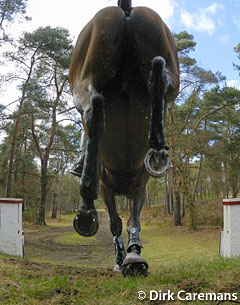 However, there are some major downsides that can be avoided with the right knowledge and technique! “I know of someone who took the shoes off straight into barefoot and the horse was lame for weeks and there are two reasons why this occurs: Firstly, the trim style is often inappropriate for this phase of being barefoot (often called transitioning). The soreness may be avoided with a subtly different initial trim. Secondly the more diseased the foot is the higher the chance the horse may be footsore even with a good initial trim - these horses benefit from having the hind shoes removed a month prior so they can cope better. It is also wise to try and avoid removing shoes if the horse has been shod in the last 4 weeks, and also if you live in an area with hard ground, try and do it during the wet season when the ground is softer.”
However, there are some major downsides that can be avoided with the right knowledge and technique! “I know of someone who took the shoes off straight into barefoot and the horse was lame for weeks and there are two reasons why this occurs: Firstly, the trim style is often inappropriate for this phase of being barefoot (often called transitioning). The soreness may be avoided with a subtly different initial trim. Secondly the more diseased the foot is the higher the chance the horse may be footsore even with a good initial trim - these horses benefit from having the hind shoes removed a month prior so they can cope better. It is also wise to try and avoid removing shoes if the horse has been shod in the last 4 weeks, and also if you live in an area with hard ground, try and do it during the wet season when the ground is softer.”
Due to the problems with many trimmers and farriers not being trained in the art of trimming performance horses, Melanie nowadays only recommends barefoot to clients who are starting to query the results of long term shoeing and are prepared to attend her performance hoof care clinics, so they are well informed about how to achieve success whilst being barefoot, or she recommends it to those people whose horses have a lifestyle that will be easy for the horse to transition to barefoot.
“I find people who are already questioning their current hoof care methods are the ones who are ready to cope with the challenges of owning a barefoot horse," said Quick. "It is mildly more labour intensive to own a horse who lives the barefoot lifestyle, as they need to wear boots during training to prevent hoof wear and they need to be trimmed more often than the standard shoeing intervals. Barefoot horses also need to have the sugar levels in their diet carefully managed. Owners who are prepared to cope with these minor changes in management are usually extremely satisfied with the resultsas their horses have more consistent soundness and performance.”
While the hoof care costs remain similar, the overall benefit is dramatic. According to Melanie there is a huge reduction in the incidence of lameness and back related pain. “I prefer horses living the barefoot lifestyle, as there is absolutely no doubt that when applied correctly it gives the horse superior hoof, leg and back health, enhanced soundness, increased career longevity, and optimizes their performance. If the competition rules can be changed to allow hoof boots in the dressage arena I think barefoot will be massive, and we will all wonder why anyone ever shod a horse.”
Olympic Disciplines Not Ready to Accept Barefoot Horses in Boots
 However, until this happens, Melanie knows that mostly pleasure riding, endurance, polo ponies and race horses will be the ones to enjoy the improvement in the quality of their life. “Sadly it is the dressage and eventing and show jumping horses who are the ones who would most benefit from having the barefoot lifestyle. I suspect the only way it will change is for the eduction level in horse owners to increase dramatically and for those who desire to have healthier horses but cannot achieve it due to the no boot rule, to start pressuring the FEI to change.
However, until this happens, Melanie knows that mostly pleasure riding, endurance, polo ponies and race horses will be the ones to enjoy the improvement in the quality of their life. “Sadly it is the dressage and eventing and show jumping horses who are the ones who would most benefit from having the barefoot lifestyle. I suspect the only way it will change is for the eduction level in horse owners to increase dramatically and for those who desire to have healthier horses but cannot achieve it due to the no boot rule, to start pressuring the FEI to change.
The FEI rules are that for dressage no boots are permitted, for our non-Olympic sports (endurance, driving, vaulting and reining) they may be used to provide emergency protection for the horse, if the horse should lose a shoe in competition, providing it is correctly sized and fitted, for eventing there are currently no regulations regarding these boots and in jumping they are used as replacement shoes.
FEI Dressage Director Trond Asmyr says "the reason why hoof boots are not allowed in FEI Dressage events is because they may be masking potential unsoundness and it is the FEI’s policy to ensure that all horses taking part in FEI events are perfectly sound and fit to compete. There are therefore no plans to change this rule."
In addition to this, trimmers, farriers and owners need to learn the subtle arts to successfully trim the large performance horse, as these are the horses who are the most challenging ones to achieve success as a barefoot horse. The bigger horses are also the most satisfying ones to have barefoot as they suffer more unsoundness when shod.
Emma Hindle Promoting Barefoot in Europe
Working as a farrier for nearly 30 years Michael Jakob was the one to put British Olympic rider Emma Hindle on the path to barefoot trimming and now has her competiting internationally and winning with the alternative form of hoof care. “I started working with horses' feet when I was 16. During my education we did a lot of different kinds of horses, e.g. racing, dressage, as well as jumping," Jakob told Eurodressage.
Having known about barefoot trimming for a long time, Jakob says this topic is not only an issue of today, but that the advantages and disadvantages of this alternative form have always been the subject of much discussion. Intially Jakob was open to the idea believing that there is not just one shoeing solution suitable for every horse, but the more options the better. “You always have to look carefully at every single case," he stated.
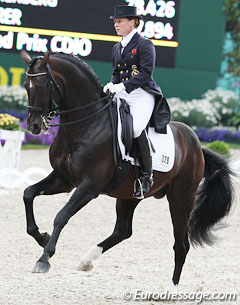 Starting to work on Emma's horses in 2007, Jakob regards barefoot trimming as a relaxing period designed to regenerate the quality and growth of the hoof and he generally recommends the practice in accordance with the owner of the horse. Once the move to barefoot has been made, Jakob explained the period of convalescence of the hoof depends on its condition at the beginning of the treatment. “A healthy hoof in combination with a careful handling will probably have no problems occuring from the change," he said. "However, if you have feet with cracks in the walls or other defects it can last some weeks or in worst cases months, for the feet to fully recover.”
Starting to work on Emma's horses in 2007, Jakob regards barefoot trimming as a relaxing period designed to regenerate the quality and growth of the hoof and he generally recommends the practice in accordance with the owner of the horse. Once the move to barefoot has been made, Jakob explained the period of convalescence of the hoof depends on its condition at the beginning of the treatment. “A healthy hoof in combination with a careful handling will probably have no problems occuring from the change," he said. "However, if you have feet with cracks in the walls or other defects it can last some weeks or in worst cases months, for the feet to fully recover.”
In these cases, Jakob advises owners to pay particular attention to balanced feeding, appropriate handling and under most circumstances a shortened period of treatment.
With most clients changing this kind of hoof treatment for therapeutic reasons, not all horses can make the change and a lot has to do with the surface they are ridden on. “It is always very difficult to judge a situation without having seen it personally but not every “shoe” suits every horse," Jakob explained. "Barefoot trimming requires very careful and responsible handling. The most important thing is the condition of the ground. A bad ground will always cause problems. In addition it is necessary to control the growth of the hooves to avoid difficulties.”
According to Jakob there are also various reasons why the horse may seem lame lame after a barefoot trim, but he says the main problem could be that the hooves are cut too short.
Jakob considers barefoot trimming a more natural hoof care solution but he believes that cost is not a real factor. Overall a happy horse is what most owners want, regardless of whether it comes in a shoe or shoeless package. “In my opinion the cost benefits should be regarded as secondary as a good and confident co-operation between owner, vet and farrier is the basis for the successful treatment of hooves," he stated.
by Sarah Warne for Eurodressage
Photos © Dirk Caremans - Astrid Appels - Private
Related Links
The Effect of Horse Shoes on Equine Hoof Shape
Shoeing the Dressage Horse by Rob Renirie
The Judging System in the Firing Line at the 2010 Global Dressage Forum
Ambitious Emma Hindle Bags Double Victory at 2005 CDIO Saumur
Victory Salute Continues Battle Against Toxic Laminitis